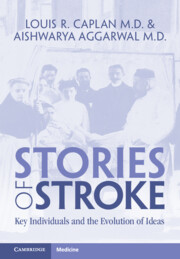Book contents
- Stories of Stroke
- Stories of Stroke
- Copyright page
- Contents
- Contributors
- Why This Book Needed to Be Written
- Preface
- Part I Early Recognition
- Part II Basic Knowledge, Sixteenth to Early Twentieth Centuries
- Chapter Four Andreas Vesalius
- Chapter Five William Harvey
- Chapter Six Thomas Willis
- Chapter Seven Giovanni Morgagni
- Chapter Eight Apoplexy
- Chapter Nine Atlases
- Chapter Ten Brainstem Syndromes
- Chapter Eleven Jules Dejerine
- Chapter Twelve Arterial and Venous Anatomy
- Chapter Thirteen Rudolf Virchow
- Chapter Fourteen Early Medical and Neurological Textbooks
- Part III Modern Era, Mid-Twentieth Century to the Present
- Part IV Stroke Literature, Organizations, and Patients
- Index
- References
Chapter Ten - Brainstem Syndromes
from Part II - Basic Knowledge, Sixteenth to Early Twentieth Centuries
Published online by Cambridge University Press: 13 December 2022
- Stories of Stroke
- Stories of Stroke
- Copyright page
- Contents
- Contributors
- Why This Book Needed to Be Written
- Preface
- Part I Early Recognition
- Part II Basic Knowledge, Sixteenth to Early Twentieth Centuries
- Chapter Four Andreas Vesalius
- Chapter Five William Harvey
- Chapter Six Thomas Willis
- Chapter Seven Giovanni Morgagni
- Chapter Eight Apoplexy
- Chapter Nine Atlases
- Chapter Ten Brainstem Syndromes
- Chapter Eleven Jules Dejerine
- Chapter Twelve Arterial and Venous Anatomy
- Chapter Thirteen Rudolf Virchow
- Chapter Fourteen Early Medical and Neurological Textbooks
- Part III Modern Era, Mid-Twentieth Century to the Present
- Part IV Stroke Literature, Organizations, and Patients
- Index
- References
Summary
During the second half of the nineteenth century and early years of the twentieth century, clinicians described instances of focal brainstem lesions at various levels. The intent was to learn the location and function of various nuclei and tracts. Some lesions were due to infarcts and hemorrhages. Others were caused by tumors, infections, or other nonvascular processes. These focal lesions were usually named after the first describers. Herein are notable examples.
- Type
- Chapter
- Information
- Stories of StrokeKey Individuals and the Evolution of Ideas, pp. 64 - 71Publisher: Cambridge University PressPrint publication year: 2022

